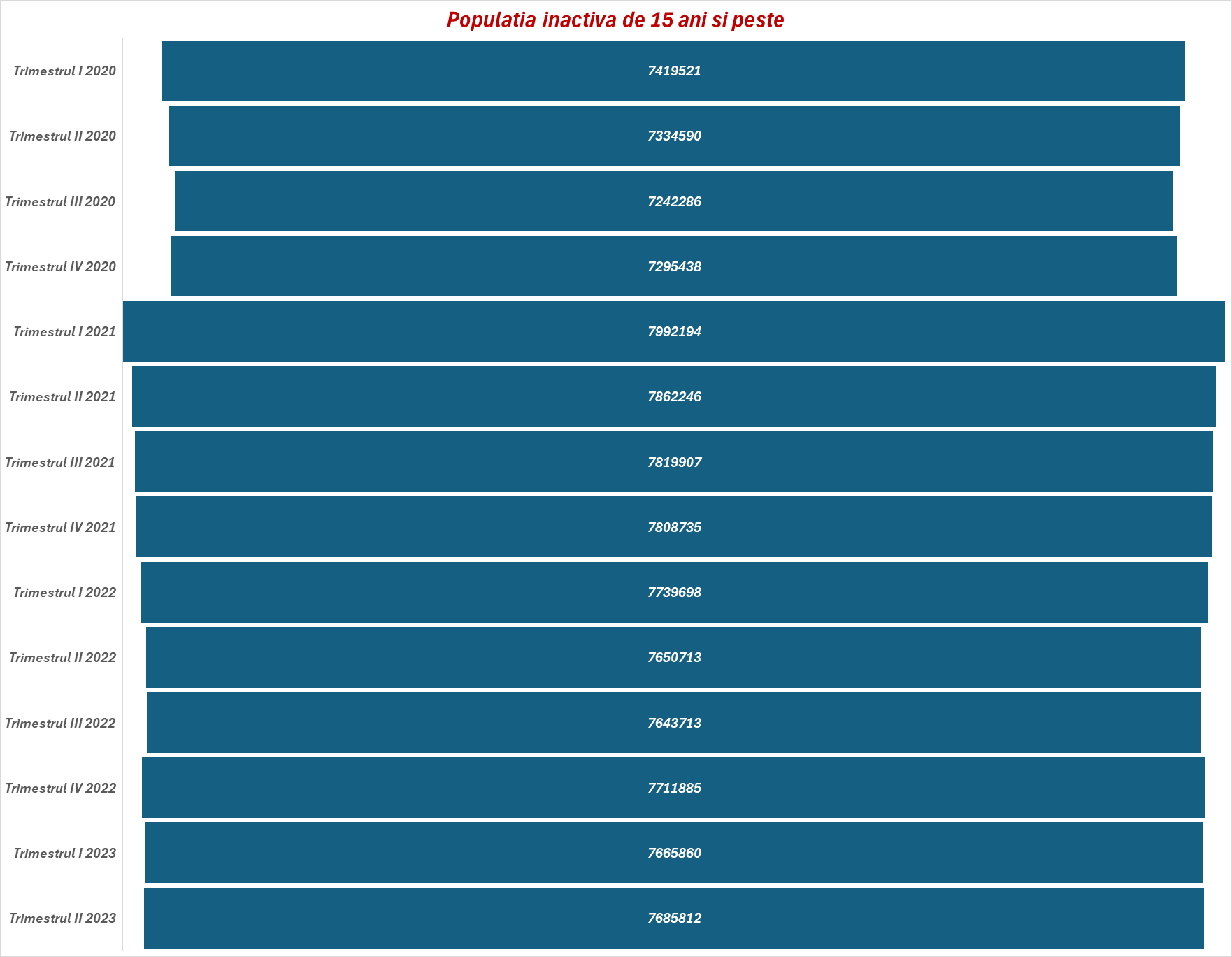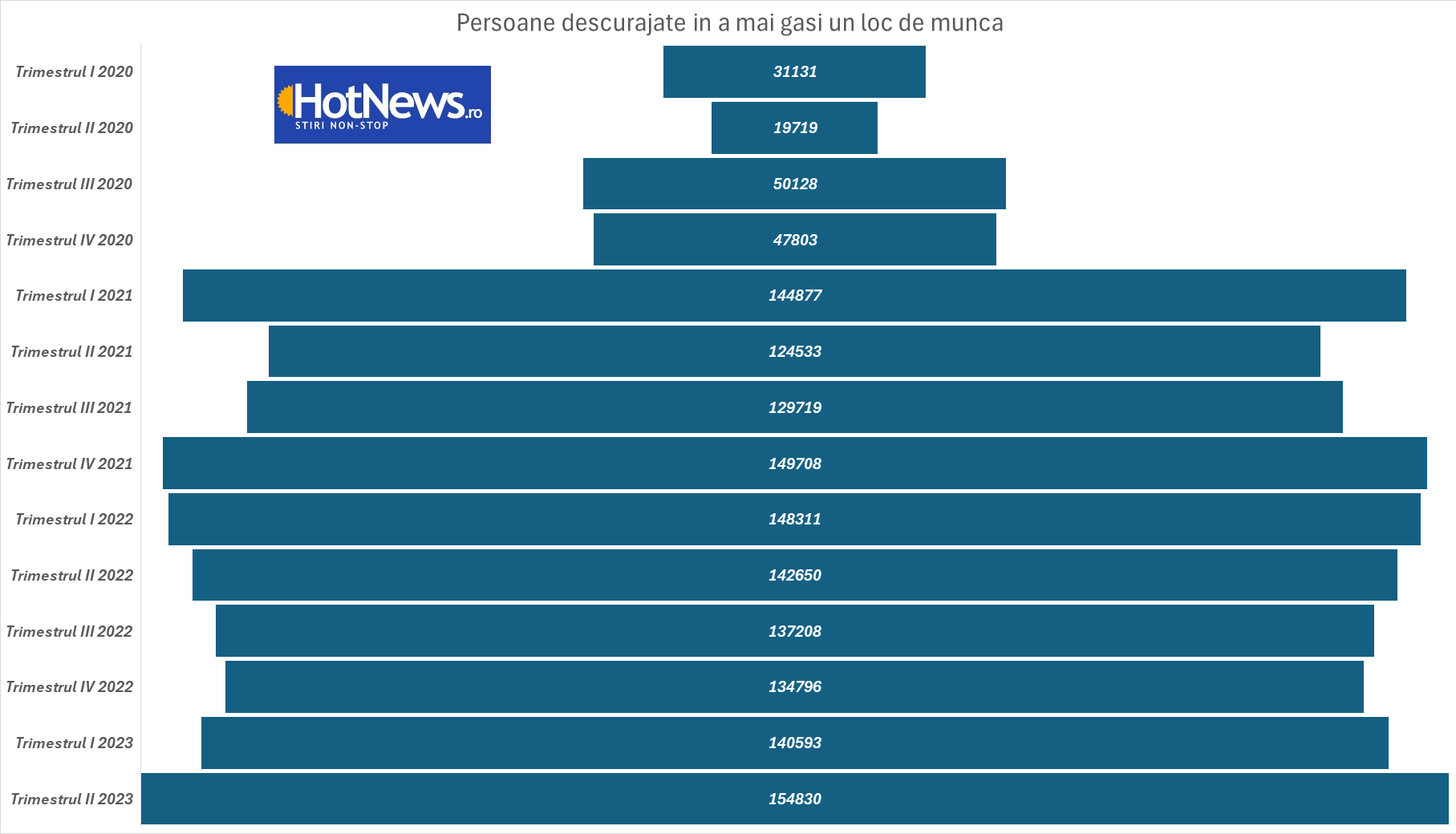
According to data sent by the INS on Tuesday, there are about 442,000 unemployed in Romania, as defined by the International Labor Office. That is, approximately the population of such a county as Arad or Dambovitsa. But the numbers are misleading.
Invisible unemployment is growing. And when I say “invisible unemployment,” I mean the discouraged and part-time workers who would like to work more hours but can’t. The official unemployment rate does not count them as unemployed. When we talk about the official unemployment rate – currently at a low level – we ignore these workers who are statistically invisible.
Below is the economically inactive population over the age of 15

This is only part of the invisible unemployment. But we also have those who are discouraged, who have given up looking for work because they have been repeatedly denied employment. And their number has increased over the past two years.

Older people are 5 times more likely to be unemployed after two years than young people under 25
With the exception of the over-50s, across all age groups, most people wait about 6-11 months before getting a new job. For people over 50, the duration of unemployment is more than two years. There are also those who are found after a month of waiting, but such cases are few (4%). “Fat” (almost a third) have been waiting for a new employer for two years.
This transition from short-term unemployment to long-term unemployment is depressing for a person who has worked continuously for 30 years and suddenly finds himself being ignored. According to statistics, more than 100,000 Romanians are in this situation.
Some find themselves in a situation of early retirement in anticipation of something they did not want and could not afford, labor market experts say.
Marian Ionescu is one of these unemployed people who are over 50 years old. He worked as a driver, but the boss preferred to hire a guy who works for much less money. “If we were in America, I could sue him for age discrimination. My experience and driving skills are not comparable to those of children. But we are in Romania, not in the Americans,” says Mr. Ionescu, who decided to become a taxi driver to earn a living.
On the other hand, employers say that those over 50 have trouble implementing digital solutions and that, in addition to high salaries, they will have to invest in courses and training for them. “Or if I hire a young digital resident, I’ve decided my part of life,” says the HoReCa entrepreneur.
It is not easier for young people either
The first reason why young people do not find a job is that they are not looking for a job, they are preoccupied with studies (530 thousand).
The second reason why young people cannot find work is precisely because they are young. Today’s young workers are largely unemployed, as they have been for the past 30 years. Precisely because they are young.
A third reason young people can’t find work is that they face the same challenges as other job seekers due to the deep recession and slow recovery.
Another reason is that the slowdown in consumption (which we are seeing during this period) leads to a decrease in aggregate demand, which leads to a decrease in the demand for labor in general. And such changes in aggregate demand affect young workers more than older ones
Blame the school…
More than half of the “unemployed” have low education, another 43.4% have secondary education. In addition to this category, underemployment, we also have emigration, which reduces the available labor force in Romania and lowers the unemployment rate.
According to a report published by the World Bank, almost 3 million Romanians of working age work abroad.
Among the Romanians who went abroad, a quarter have a higher education. Brain drain can have serious consequences for Romania’s future development, and cities such as Bucharest, Cluj, Iași and Timişoara are fully feeling this pressure on the labor market.
A significant problem here is that the number of jobs created by the economy – especially well-paid jobs with career prospects – is decreasing. According to some labor market specialists, the number of Romanian graduates with higher education is increasing significantly, while the number of jobs requiring higher education is not increasing as much. In other words, there is a very wide gap between what the real economy offers and what the generations entering the labor market with increasingly higher qualifications offer.
In theory, a low rate means that workers are able to take care of themselves, that the labor market is strong, and that employers and workers exchange the factor of production “labor” well.
In 2023, the number of workers receiving the minimum wage increased significantly to reach 1.897 million. Practically, this is a 52% increase compared to December 31 and represents almost a third (28%) of all employment contracts.
Economists consider the unemployment rate as an indicator of pressure in the bowels of the economy.
If many workers are unemployed, low unemployment does not necessarily mean a strong labor market.
The fact that salaried workers get and stay in low-wage jobs is a sign of insufficient supply of jobs.
Where to start labor market reforms? 5 main directions
1. Parametric reform of the state pension system with the cancellation of special pensions and their recalculation based on the principles of the state system of contributions (pension points), while observing the principle that no pension can be paid. will not be reduced. At the same time, the method of indexation of the pension score will be revised to ensure a constant connection between its value as a basis for calculating the replacement income from work (pension) and the main remuneration of the factor of labor production, respectively, wages. ;
2. Reforming the institutions of the labor market by returning to an integral system of labor relations based on a collective labor agreement at the national level, simultaneously with the introduction of a partnership mechanism for establishing the minimum wage with the active involvement of social partners;
3. Reform of public service pay by creating a single pay system for all civil servants, as well as for contractors. Solving the problem of accumulating old-age pensions with wages in the public service by establishing certain mechanisms to stimulate active aging, on the one hand (participation in the labor market and beyond the standard retirement age), and on the other hand, to limit the abuse and waste of public resources;
4. Reform of local state administration, especially by uniting UAOs, adhering to the principle of their economic and fiscal viability in order to reduce their use of state budget resources;
5. Reform of the social health insurance with the aim of reducing waste in the system and tying the services offered to the patient to the amount of the contribution to the social health insurance system. This reform should be aimed at creating a dual system consisting of a basic non-contributory component financed directly from the state budget and a contribution component effectively financed by social health insurance contributions, and in which the services offered are linked to the amount contribution, as well as the duration of the contribution period accumulated in the system.
Source: Hot News
Lori Barajas is an accomplished journalist, known for her insightful and thought-provoking writing on economy. She currently works as a writer at 247 news reel. With a passion for understanding the economy, Lori’s writing delves deep into the financial issues that matter most, providing readers with a unique perspective on current events.